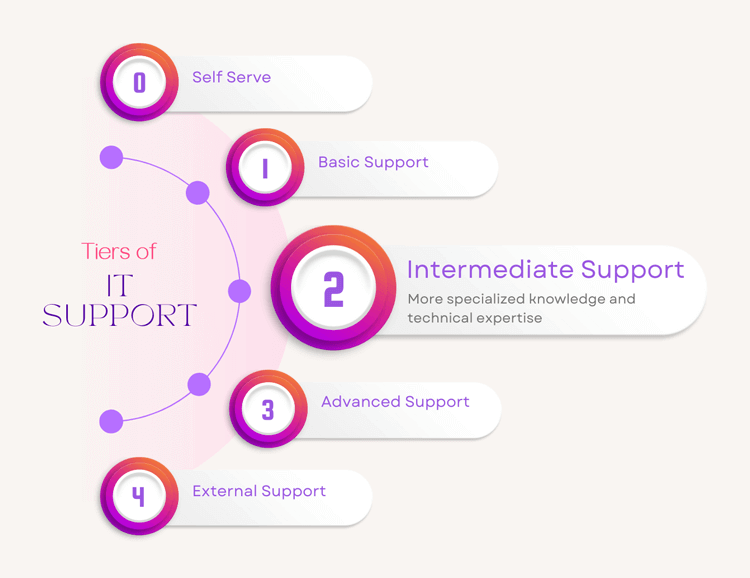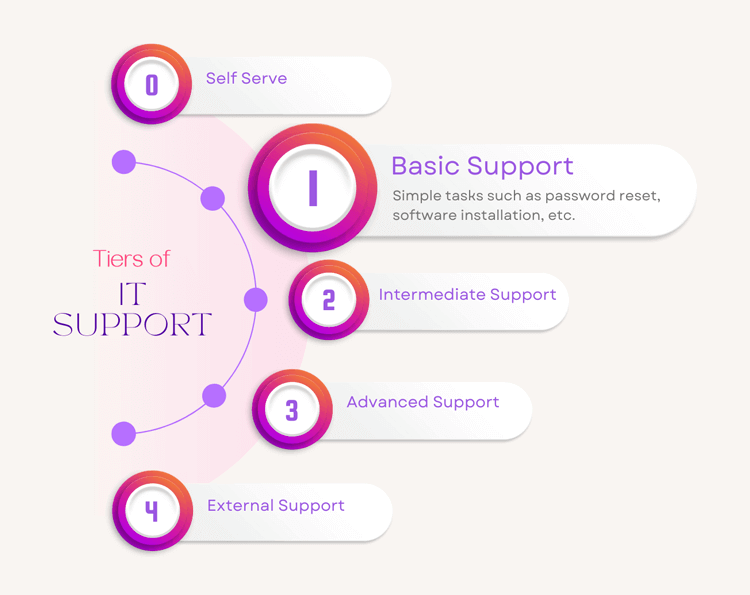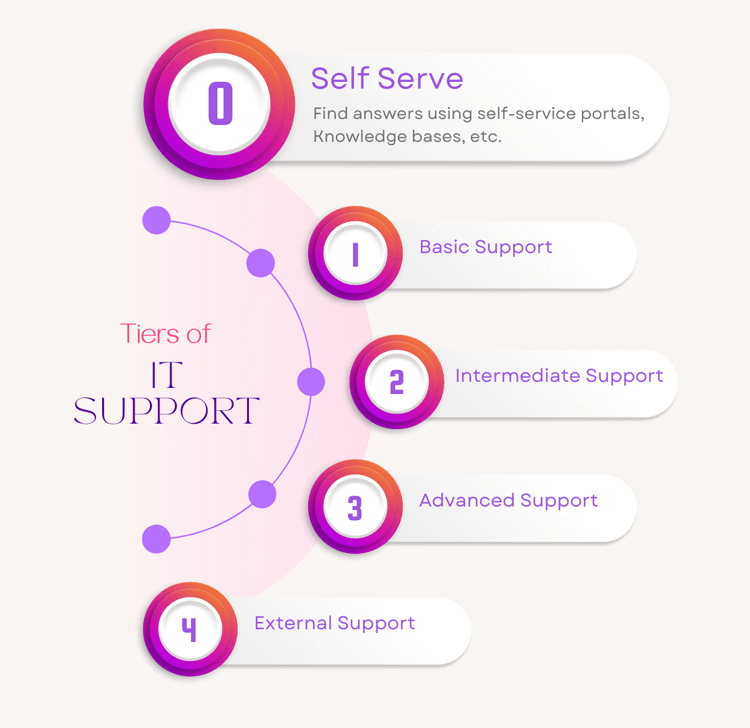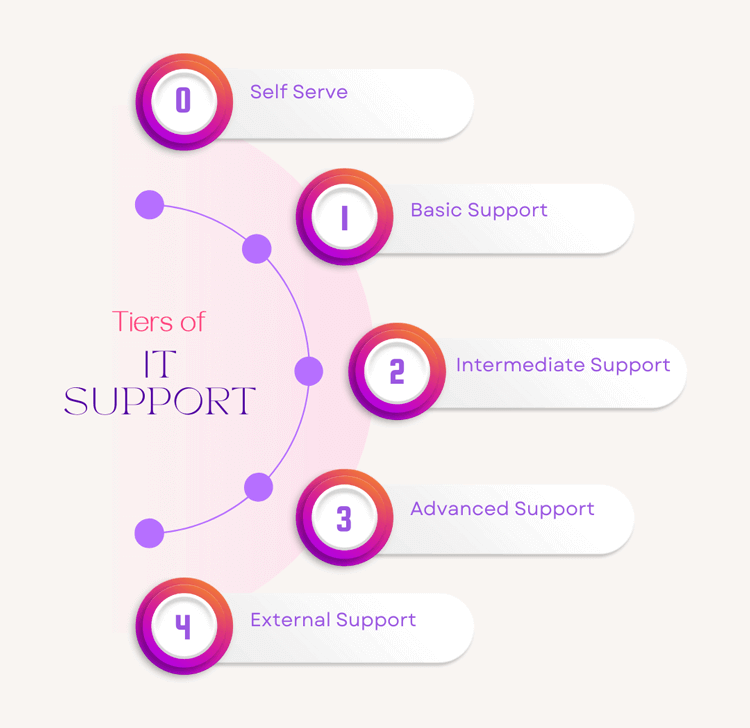Tier 2 IT Support Fully Explained: Level 2 Tech Support
Tier 2 IT Support, also known as Level 2 IT Support, is a more advanced level that handles technical issues that cannot be resolved by Tier 1 agents.
Tier 2 support staff are normally more experienced and have a deeper understanding of the organization's IT infrastructure, applications, and services.

TL;DR
- Almost everyone who uses software, email, and devices in the workplace encounters problems every so often. Tier 2 handles more complex issues that self-serve (Tier/Level 0) and the front-line, Tier 1 agents can't handle.
- Tier 2 ITSM agents may interact with users directly, but they also work closely with Tier 1 to provide guidance and support when an issue is escalated.
- Accessing ITIL user support, usually by submitting a support ticket via help desk software, will always go through to Tier 1 agents first.
- However, either manually or automatically, when an issue is more complex it goes up to Tier/Level 2.
Read on for details...
What is Tier 2 IT Support (Level 2)?
Tier 2 team members are responsible for diagnosing and resolving more complex technical problems. This often requires specialized knowledge or tools.
Whether delivered by an organization's IT department or a third-party IT customer service team/vendor, Tier 2 is critical for resolving issues quickly while safeguarding higher-level resources for more complex issues.
Only if Tier 2 can't resolve a problem, the issue may be escalated further to Tier 3 or even Tier 4 support. Tier 2 IT Support is essential to the IT service management (ITSM) process because it serves as the bridge between basic support (Tier 1) and even more advanced troubleshooting (Tier 3).
Tier 2 also plays a key role in incident management, as it often deals with root cause analysis and provides insights that can help prevent future occurrences of similar problems.
Why Does Tier 2 IT Support (Level 2) Play a Critical Role in ITSM and Help Desks?
Tier 2 is an integral part of any ITSM framework that serves to keep downtime to a minimum. It acts as a crucial next step when an IT issue is beyond the skills and abilities of Tier 1 agents.
As ITSM organizations continue to support digital transformation strategies, the amount of IT support has increased for every company. When Tier 2 handles more complex and specialized issues, it takes some of the strain off Tier 1 and hopefully prevents a further escalation to Tier 3 or 4.
When ITSM teams and ITIL operators move tasks to Tier 2, help desk teams can reduce operational costs, and improve overall service levels and customer service scores (e.g., CSAT, NPS, etc). Tier 2 issues are given more time to reach a resolution because they're more complex, so SLA times are extended.
Pros and Cons of ITSM Tier 2 IT Support
With five tiers of IT support, from self-serve to the most advanced technical support, your organization will benefit from having all five tiers to support your staff. Here are the pros and cons of Tier 2 support.
Pros of Tier 2 IT Support
- Expertise in Complex Issues: Tier 2 support technicians have more technical knowledge. This can enable them to address more complex and specialized issues that Tier 1 cannot resolve. Depending on your organization's tech stack, Tier 2 might have specialist platform knowledge, or experience working with particular software and hardware tools.
- Improved Resolution Rates: By handling more difficult problems, Tier 2 support increases the likelihood that issues will be resolved before needing to be escalated either further up, or externally. All of this helps keep downtime to a minimum while improving SLA scores.
- Enhanced User Experience: Users receive more specialized support. This should result in faster resolution times and improved customer satisfaction.
- Better Incident Management: Tier 2 plays a critical role in identifying and resolving recurring issues. This can help improve overall system stability. Tier 2 agents often make a greater contribution to knowledge bases, self-serve portals, and internal training.
- Resource Optimization: By filtering out more challenging issues, Tier 2 support allows Tier 3 and Tier 4 teams to focus on strategic projects and truly complex problems.
Cons of Tier 2 IT Support
- Higher Staffing Costs: Tier 2 support typically requires more skilled and, therefore, higher-paid staff, which can increase operational costs. Even if you work with an ITSM vendor, this level of support will be more expensive.
- Potential Bottleneck: If Tier 2 is overworked with tickets or not properly staffed, it can become a serious bottleneck, delaying issue resolution.
- Training & Knowledge Management: Ensuring that Tier 2 staff are up to date with the latest technologies and standard operating procedures (SOPs) requires ongoing training and knowledge management efforts.
- Escalation Complexity: Poorly defined escalation procedures can lead to confusion and inefficiencies when issues need to be passed from Tier 1 to Tier 2 or beyond. The best way to counteract this is with an AI-powered ticketing system that should avoid issues with tickets being assigned to Tier 1 when they actually belong to Tier 2.
- Dependency on Documentation: Tier 2 support relies heavily on accurate knowledge-base documentation. If this information is lacking or inaccurate, it can hinder problem resolution. Or if issues have traveled via Tier 1 first: Have they collected everything a Tier 2 agent needs in order to find a solution to the problem?
How to Setup Tier 2 IT Support: 5 Stages for an IT Help Desk
Setting up an effective Tier 2 IT Support team involves several critical steps:
- Define the Scope of Tier 2: Clearly define the types of issues that Tier 2 will handle. This typically includes advanced troubleshooting, configuration issues, and problems requiring specialized tools or knowledge. Establish clear guidelines for when issues should be escalated to higher tiers.
- Recruit and Train Staff Well: Hire staff with strong technical backgrounds and experience in the relevant technologies and systems. Provide them with advanced training on your organization's specific IT environment, including any proprietary systems or software.
- Implement a Robust Ticketing System: Develop clear procedures for how and when issues should be escalated from Tier 1 to Tier 2, and from Tier 2 to higher tiers if necessary. Use an AI-based ticketing system that should filter 90% of these escalations automatically. Ensure that these procedures are well-documented and communicated to all ITSM and ITIL staff.
- Have a Knowledge Base and the Right Resources: Make sure the Tier 2 team has the necessary tools and resources to diagnose and resolve complex issues. This should include access to advanced monitoring tools, detailed, data-backed system logs, and a comprehensive knowledge base.
- Monitor Performance and Provide Continuous Feedback: Regularly review the performance of your Tier 2 support team. Use this data to identify areas for improvement and provide ongoing training as needed.
How Does Tier 2 Compare to Other ITSM Support Tiers?
For more information on every tier of IT support, here is our 5 Tiers of IT Support Explained: Tier 0 to Tier 4, ultimate guide.
Tier 2 vs Tier 0
Tier 0 is the self-service solution, while Tier 2 involves much more complex troubleshooting and issue resolution.
Tier 0 is focused on self-service, where users resolve issues on their own using available resources like FAQs and knowledge bases. Tier 2 handles everything that Tier 0 and Tier 1 can't manage.
For more information on Tier 0 support, here's our article on Tier 0 (Level 0) IT Support.
Tier 2 vs Tier 1
Tier 2 support is for more complex issues that require deeper technical knowledge and expertise than Tier 1.
While Tier 1 handles simpler troubleshooting, Tier 2 IT staff handle and solve problems that require more in-depth and specialized knowledge. Technical issues at this level always take longer to solve, so SLA-based KPIs are adjusted to accommodate the more time-consuming work involved.
For more information on Tier 1 support, here's our article on Tier 1 (Level 1) IT Support.
Tier 2 vs Tier 3
Tier 3 is typically reserved for issues that require much higher levels of technical skills, such as serious bug fixes, and platform knowledge, such as AWS, Google, Microsoft, Intel, etc.). Tier 3 agents can also be involved in more complex system integrations.
While tier 2 helps to resolve somewhat less-complex problems, Tier 3 involves dealing with much more complex technical challenges.
At Tier 3, IT staff are usually involved in strategic decisions and implementations. This could involve, but wouldn't be limited to, digital transformation, platform migrations, and in-house software development. Tier 3 staff often work with external vendors to deliver these projects.
For more information on Tier 3 support, here's our article on Tier 3 (Level 3) IT Support.
Tier 2 vs Tier 4
Tier 4 often involves working with external vendors and consultants who attempt to solve issues beyond the capabilities of an in-house team, or even a contracted ITSM vendor.
For more information on Tier 4 support, here's our article on Tier 4 (Level 4) IT Support.
How Do Different Tiers of IT Support Work Together to Make a Functional ITSM Team?
Different tiers of IT support need to work together to create a seamless, efficient IT support system. The larger the organization, the more IT support is required. Some companies have a hybrid of an in-house team while working with an external vendor.
The different tiers of IT support work together by handling issues with the appropriate level of expertise. This ensures that users receive timely and effective resolutions.
- Tier 0 allows users to resolve simple issues independently using self-serve tools.
- Tier 1 handles basic support requests.
- Tier 2 steps in for more complex issues.
- Tier 3 and Tier 4 handle everything else and work with external vendors to deliver the results an organization needs.
Key Takeaways: Why Your Organization Needs Tier 2 IT Support
Tier 2 IT support is essential for managing more complex technical issues that can't be tackled with basic troubleshooting at Tier 1.
Tier 2 enhances the efficiency of the ITSM process, reduces the need for escalations to Tier 3, and improves user satisfaction.
Implementing a strong Tier 2 support structure is crucial for any organization looking to maintain a robust and effective IT support system. Tier 2 does this so that issues are resolved quickly and effectively without overloading higher-tier resources.
Giva Can Help Your Tier 2 IT Support
Giva's help desk and ITSM software bring you real-time, highly-customizable dashboards with a large widget library. You'll be up and running in days, and your IT help desk and service desk teams can be trained in hours on our intuitive and friendly interface.
Other Giva features include:
- Harness the power of Giva's AI Copilot to effortlessly refine responses and quickly access and format solution information
- Automatically convert emails into tickets to streamline the ticketing process
- Customize Giva for any department or subsidiary organization and deliver real-time agent and team analytics to help improve performance
- Automatically open tickets on a scheduled and recurring basis
- Automate escalation and closure of tickets
To learn more, book a free Giva demo to see our solutions in action, or start your own free, 30-day trial today!





